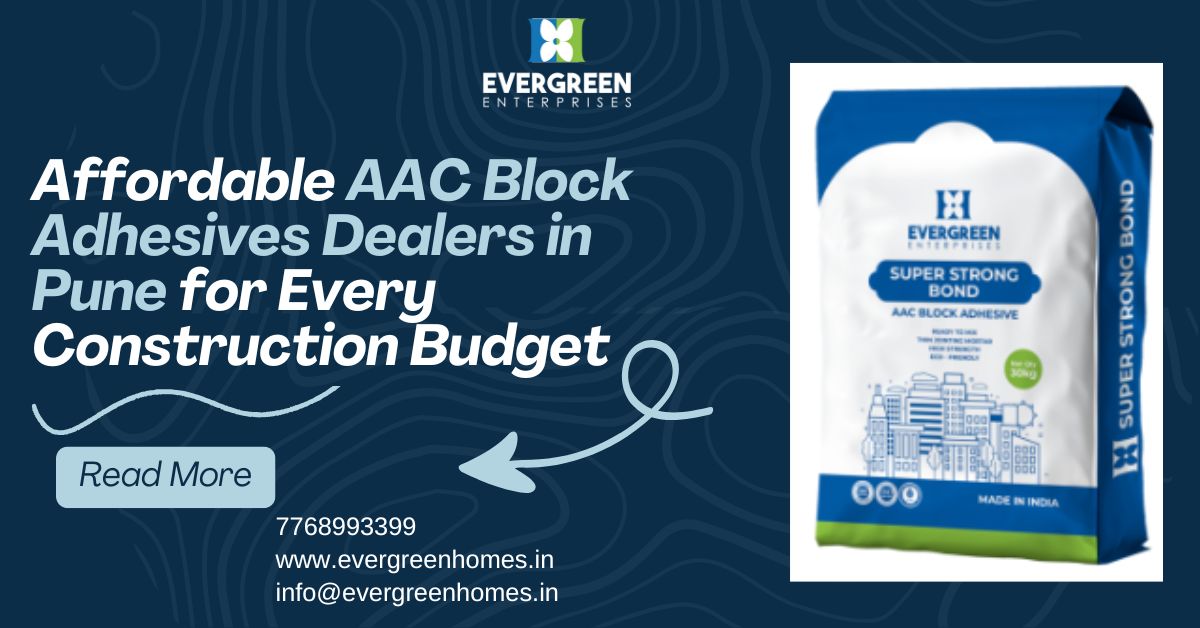DIY Homeowner’s Guide: Building a Small Garden Wall with AAC Block Jointing Mortar by Evergreen Enterprises

Creating a charming garden wall can transform your outdoor space, offering both functionality and aesthetic appeal. For DIY enthusiasts, using Autoclaved Aerated Concrete (AAC) blocks coupled with proper AAC Block Jointing Mortar is an ideal combination of ease and performance. In this guide, Evergreen Enterprises walks you through the step-by-step process of building a small garden wall—perfect for defining borders, supporting climbing plants, or simply adding an architectural element to your yard.
Why Choose AAC Blocks and AAC Block Jointing Mortar?
1. Lightweight and Easy to Handle
AAC blocks weigh significantly less than traditional concrete or clay bricks. This makes them perfect for DIY projects, especially when constructing a low-height garden wall. Handling and placing the blocks requires less effort, reducing fatigue and the risk of damage or injury.
2. Excellent Thermal and Acoustic Insulation
Although a garden wall is not a full structure, AAC blocks still offer superior insulation properties. This helps moderate temperature around planter beds or raised garden features, creating a more stable microclimate for sensitive plants.
3. Thin-Bed Application with AAC Block Jointing Mortar
Traditional brick-and-mortar construction typically demands a 10–12 mm mortar joint. In contrast, AAC Block Jointing Mortar allows for a thin-bed joint of only 2–3 mm. The benefits of thin-bed jointing include reduced mortar consumption, faster build times, and fewer gaps, resulting in a neater finish.
4. Durability and Pest Resistance
When properly applied, AAC Block Jointing Mortar creates a strong bond between blocks, resulting in a wall that resists weathering, pest infestation, and minor settlement movements.
Materials and Tools You’ll Need
- AAC Blocks (quantity based on wall length and height)
- AAC Block Jointing Mortar (pre-mixed polymer-enhanced mortar from Evergreen Enterprises)
- Masonry Trowel (for spreading mortar)
- Spirit Level (to keep blocks plumb and level)
- Measuring Tape and Pencil (for marking dimensions)
- Chalk Line (to maintain a straight course)
- Rubber Mallet (for gently tapping blocks into place)
- Bucket and Mixing Paddle (if mixing mortar on-site; some premixed mortars require only water)
- Protective Gear: Gloves, safety glasses, and dust mask
Step 1: Planning and Layout
- Determine Wall Dimensions: Measure the length and height (e.g., 3–4 ft high by 10–12 ft long). Calculate how many AAC blocks you need by dividing the total length by the block length (≈600 mm) and allowing for 2–3 mm mortar joints.
- Select Mortar Grade: Choose Evergreen’s “SuperJoint” for general use or “Super Eco Joint” for an eco-friendly option—both are thin-bed mortars with strong adhesion and weather resistance.
- Mark the Foundation: Snap a straight, level chalk line outlining the wall. If the ground slopes, either build up with compacted gravel or cut into the slope so the footing stays level.
Step 2: Preparing the Foundation
- Excavate and Compact
Dig a trench about 6–8 inches deep along your chalk line, wide enough to fit one AAC block plus a working margin. Fill the trench with crushed stone or gravel and compact it firmly to create a stable, level base. - Lay a Concrete Screed (Optional)
For added stability—especially in areas with frost or heavy rain—pour a 2–3 inch concrete screed over the compacted gravel. Allow it to cure for at least 24 hours to ensure a perfectly flat surface for your first course of AAC blocks.
Step 3: Mixing and Applying the AAC Block Jointing Mortar
Mixing Guidelines
- Pre-packed Mortar: Add clean water at a 0.2–0.25 water-to-mortar ratio. Mix with a paddle until you have a smooth, trowelable paste.
- Bagged Polymer-Enhanced Mortar: Sift to remove lumps, then slowly add water while mixing. Aim for a peanut-butter–like consistency—firm enough to hold its shape but spreadable in 2–3 mm layers.
Applying the First Course
- Spread a 2–3 mm layer of mortar onto the screed or compacted gravel with a trowel.
- “Butter” one end of the first AAC block with mortar and set it at your starting point. Use a spirit level to ensure it’s plumb and level.
- Continue buttering and placing blocks side by side, keeping joints at a uniform 2–3 mm (use a small spacer or thumb pressure to guide you).
Layer by Layer Construction
- After laying the first course, allow the mortar to firm up for about 20–30 minutes (or per manufacturer instructions) to prevent blocks from shifting.
- For the second course, apply mortar on top of the first, then use a half-block stagger (“bird’s mouth”) so each block overlaps two below it—this improves stability.
- Continuously check level and plumb, tapping blocks gently with a rubber mallet as needed. Ensure all joints are fully filled, with no voids.
Step 4: Finishing Touches
- Capping the Wall
Once you reach the desired height, apply a bead of AAC Block Jointing Mortar to the top course and set specialized AAC copings or concrete caps. Ensure each cap has a slight outward slope (about 1:100) to direct rainwater away.
- Tooling the Joints—After 15–20 minutes—when the mortar begins to stiffen—run a jointing tool or rounded stick along each horizontal joint to compact the mortar and create a clean, concave finish.
- Curing – The mortar will set initially in 4–6 hours and gain full strength over 7–14 days. For the first 48 hours, mist-spray the wall to keep it damp. In hot or sunny conditions, cover the wall with burlap or plastic to prevent rapid drying and ensure optimal bond strength.
Tips for a Successful DIY AAC Garden Wall
- Maintain Consistent Joint Thickness: Even minor variations beyond 3 mm can affect stability. Consider using temporary spacers or a joint gauge.
- Work in Manageable Sections: If you’re new to masonry work, split the wall into smaller segments (e.g., 2–3 feet at a time). This prevents mortar from setting before you complete each section.
- Check Alignment Frequently: Small deviations accumulate. Use a long spirit level and a plumb line to keep courses true.
- Protect Against Rain: If unforecasted rain is likely, cover your work area with a tarp. Rain can wash away fresh mortar, compromising bond strength.
- Safety First: Wear sturdy gloves and dust masks when cutting AAC blocks or mixing mortar. Even though AAC is less dusty than traditional concrete, fine particles can irritate lungs and skin.
Conclusion
Building a small garden wall with AAC blocks and AAC Block Jointing Mortar from Evergreen Enterprises is both achievable and rewarding for the DIY homeowner. By leveraging the lightweight nature of AAC, the efficiency of thin-bed jointing mortar, and following proper construction steps, you’ll enjoy a durable, aesthetically pleasing wall that adds value and charm to your outdoor space. Remember: take your time during preparation, maintain consistent joint thickness, and follow curing best practices. With patience and attention to detail, your new garden wall will stand strong for years to come—providing a beautiful backdrop for plants, seating, or pathway borders. Happy building!



